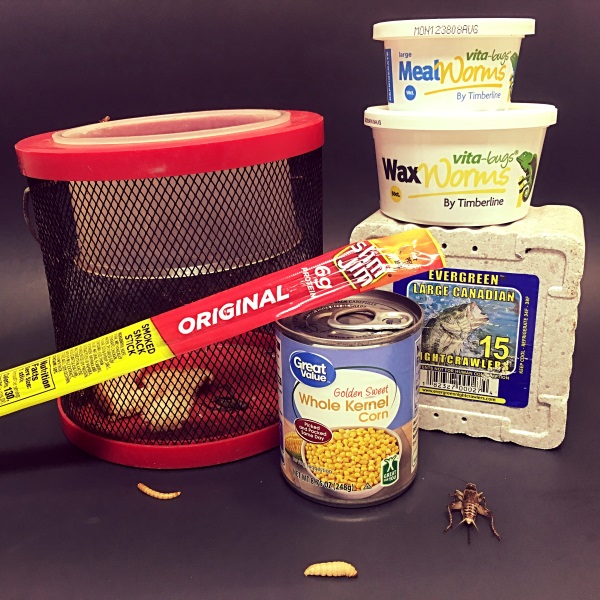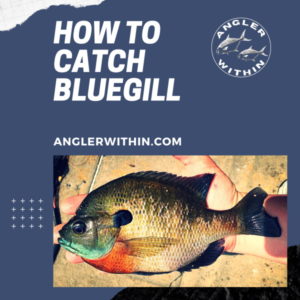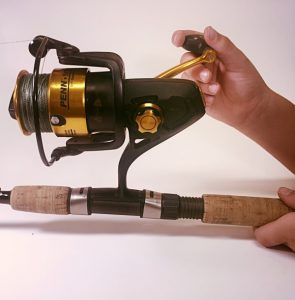
Not every bluegill bait is available to us at all times, so it’s helpful to know a little bit about all the best options. That way, no matter where you are, or your current circumstance, you know how to obtain a solid bluegill bait for your fishing trip.
I’ll discuss all of the best options that I have tried, and tell you why you might, or might not, want to use each one.
- Crickets
- Worms
- Waxworms
- Canned Sweet Corn
- Mealworms
- Slim Jim's
- Bread
- Grasshoppers
- Spikes (Maggots)
Crickets - my favorite bluegill bait
Crickets are widely considered to be the most effective bait for bluegills. I like crickets not only because bluegill love them, but also because they are cheap, widely available, and less messy to deal with than worms.
You will want to make an $8 investment in a cricket cage if you plan to fish with crickets. You can see my red cricket bucket in the image below. This is a way better option than other temporary containers you might get at a bait store.
Crickets are almost always available at any bait shop. They can also be purchased from pet stores and some gas stations.
Crickets need very little supervision while you are fishing – just keep them in the shade when possible. You can even keep leftover crickets for fishing another day. However, they can be a little annoying with their chirping between fishing trips.
There are a handful of ways to hook a cricket. I like to use a number 6 or 8 long shank cricket hook, and thread the hook through the body, exposing the hook point. Others prefer to hook them in the hard collar, right behind the head. It seems like I have more crickets stolen off the hook when I hook them through the collar, so that isn’t my preference.
Although crickets don’t live long after they’ve been hooked, you shouldn’t need them alive very long anyway. From my experience, if the bluegills are there, the cricket won’t be there for very long. If you feel like you may need to re-bait a lifeless cricket, do it, crickets are cheap.
With any of the bait options listed on this page, I like to fish all of them under a small bobber with a split shot. At times, I will free line baits, but there is something nostalgic about watching a bobber shoot under the water. To me, a bobber captures the essence of bream fishing.
Worms - nightcrawlers, red worms, and others
Whether we are talking about nightcrawlers, red worms, or some other species of worm, they are, without a doubt, one of the greatest bluegill baits. If you’re trying to catch ALL manner of sunfish (i.e. redear), and not just bluegill, worms might be a better option than crickets. It seems like worms have a wider appeal than crickets do.
The two best things about worms are that you are almost guaranteed to get a bite by some fish or another, and, they are available everywhere. You can buy them from bait shops, Walmart, Academy Sports, and even some gas stations. You can even collect them from your yard, or scrounge some up from a neighborhood park. I don’t think there is a more readily available bait in America.
When using worms, you should only use small pieces, and not the whole worm. Even rather large bluegills still have very small mouths. So, you will want to keep the bait sized down.
I’ll cut a nightcrawler into 3 to 10 different baits, depending on what size fish I’m after. Be sure not to leave a portion of the worm dangling off the hook, or they will grab it and yank the bait off the hook
A small section of worm under a cork is hard to beat for bluegills.

Waxworms - aka "waxies"
Wax worms, sometimes referred to as “waxies”, are the larvae of the wax moth (bee moth). These fat little caterpillars make excellent bluegill bait.
Check out the wax worm at the bottom middle of the image above. Notice how it’s only slightly smaller than the body of a cricket – about 3/4″ max. So, they are a nice size for a bluegill bait. You will typically only need to put one on the hook at a time – no need to break them into pieces.
Because waxies are a common feed for pet reptiles and birds, they are widely available in pet stores. So, even if you don’t have a bait shop nearby that sells them, you can either purchase them online, or purchase them at a pet store. I was able to purchase a plastic cup of 50 at my local Petco (shown in the image above).
Wax worms are fairly cheap, and will survive for weeks with little care. Just keep them dry, and cool, at around 50 degrees. Most fridges will be a little too cold, so you can store them at room temperature for a while, and they should be fine. Store them in a breathable container, with sawdust, and a lid, and do not feed them.
I like wax worms because they are a lot less messy than dealing with earthworms. Like a cricket, one waxworm equals one bait.
You will want to thread them onto the hook to prevent bluegills from stealing them without getting hooked.
An interesting side note is that these things can eat through some forms of plastic, including shopping bags. So, if you put them into a plastic container, make sure the container is not really thin, or you might have some escapees.
If you want to try to grow your own wax worms for bait, there is a good wiki article about that here: How To Breed Waxworms
Mealworms - aka "mealies"
Meal worms are another excellent larvae bait for bluegills. They are the larvae of the mealworm (darkling) beetle. The image above shows a live mealworm on the bottom left. Notice that it’s a lot smaller than the wax worm shown in the middle.
Supposedly mealworms are edible by humans, and are a great source of protein – yuck! More commonly, like wax worms, they are used to feed pet reptiles and birds. Therefore, they are frequently found in pet stores, and that is where I buy mine. You can also easily find them available online.
I’m sure there are lots of places that stock mealies locally for fish bait, but I couldn’t find any such place in my area. No big deal though. I was able to find them immediately in the reptile section of my local Petco.
You can even grow your own mealworms for a cheap bait option. There is tons of info available online to tell you how to do so.
Grasshoppers
I don’t usually use grasshoppers, but they are an excellent bluegill bait – probably better, in fact, than crickets. Grasshoppers are another one of those summer time options that you can use in a pinch, if other baits are not readily available, or if you run out of bait.
I remember gathering them up as a kid because, like worms, they are free! I’m too lazy to do that now, but there is no doubt grasshoppers are very effective. You won’t find a quality bait at a better price – free. But, let’s be real, who has time to catch grasshoppers. Just buy some crickets. 😉
Canned Sweet Corn - extremely cheap bluegill bait
Corn is a great option when you want to go bream fishing, but don’t have time to go to the bait store. Simply grab a can from the kitchen cabinet, and scoop a few tablespoons into a plastic bag. You won’t need the whole can, unless you have an army of anglers with you. Just use the rest for a meal at home, or save it for later use.
Corn is a very hardy bait, and sometimes will last through several fish. Put 1 or 2 kernels on a small hook, and fish it under a bobber.
Besides availability, another advantage to corn is that it isn’t smelly or gross. So, it’s great when fishing with kids, as they aren’t intimidated by it, and they don’t get nastiness strewn everywhere. Oh, and it’s very cheap!
Slim Jim - Yep, meat sticks make good bluegill bait
Meat sticks are another one the “convenience baits“. You can get them at pretty much any gas station. So, if the bait store is closed, no problem, pick up some Slim Jim’s instead. Worst case scenario, you have something to snack on while watching your bobber.
In all seriousness, bluegills do like Slim Jim’s. They are very greasy and oily in the water. I suspect the amount of scent pouring off of them is what contributes to their effectiveness. One small piece may catch you more than 1 fish, but don’t leave it on too long. It seems as though it gets washed out after some time in the water. So, keep refreshing your bait.
Slim Jim’s are particularly convenient if you are after small gills for the purpose of bass or catfish bait. That is mostly what I use them for. If I’m preparing for a true bluegill outing, I’ll go with one of the other listed bait options.
Bread
Bread is a great bait for bluegills, but the obvious downside here is that bread dissolves fairly quickly in the water. This isn’t necessarily a problem if you are on a hot fishing spot. When the fishing is good, your bait is only going to be in the water a few seconds anyway.
This is another bait option that shouldn’t necessarily be your primary choice for a pre-planned trip. But, in a pinch, you can grab some bread and hit the water.
Just take a piece of sandwich bread, or bun, and squish it around the hook the best you can. You can expect it to get hit rather quickly if bluegills are around.
Spikes - aka "maggots"
Admittedly I have not actually used these myself, and, I hesitated to include them in this list. But, they seem to have such a good reputation, I felt the list would not be complete without at least mentioning them.
Maggots are another larvae that is apparently a quality bluegill bait. They are commonly referred to as “spikes”. Spikes seem to be more frequently used up North, and are particularly useful as ice fishing baits.
These fly larvae are usually less than ½ inch long, so they are a great size for tipping jigs, or you can add more than one to a hook to make a substantial bluegill bait.
There are many suppliers online that will ship them to your door.
Other Options
A few final honorable mentions are Catalpa worms (catalpa caterpillars), small minnows, various artificials, hot dogs, and other small insects.
Conclusion
Any of the selections listed above should serve you well as bluegill bait. There are many other options that will work, and it seems this list could be endless. But, from what I know, the baits listed here are thoroughly proven options. Maybe I’ll run across another great option, and if I do, I’ll be sure to update this list in the future.
Now, go load the cooler with some tasty bluegills!
Augustus Clay



